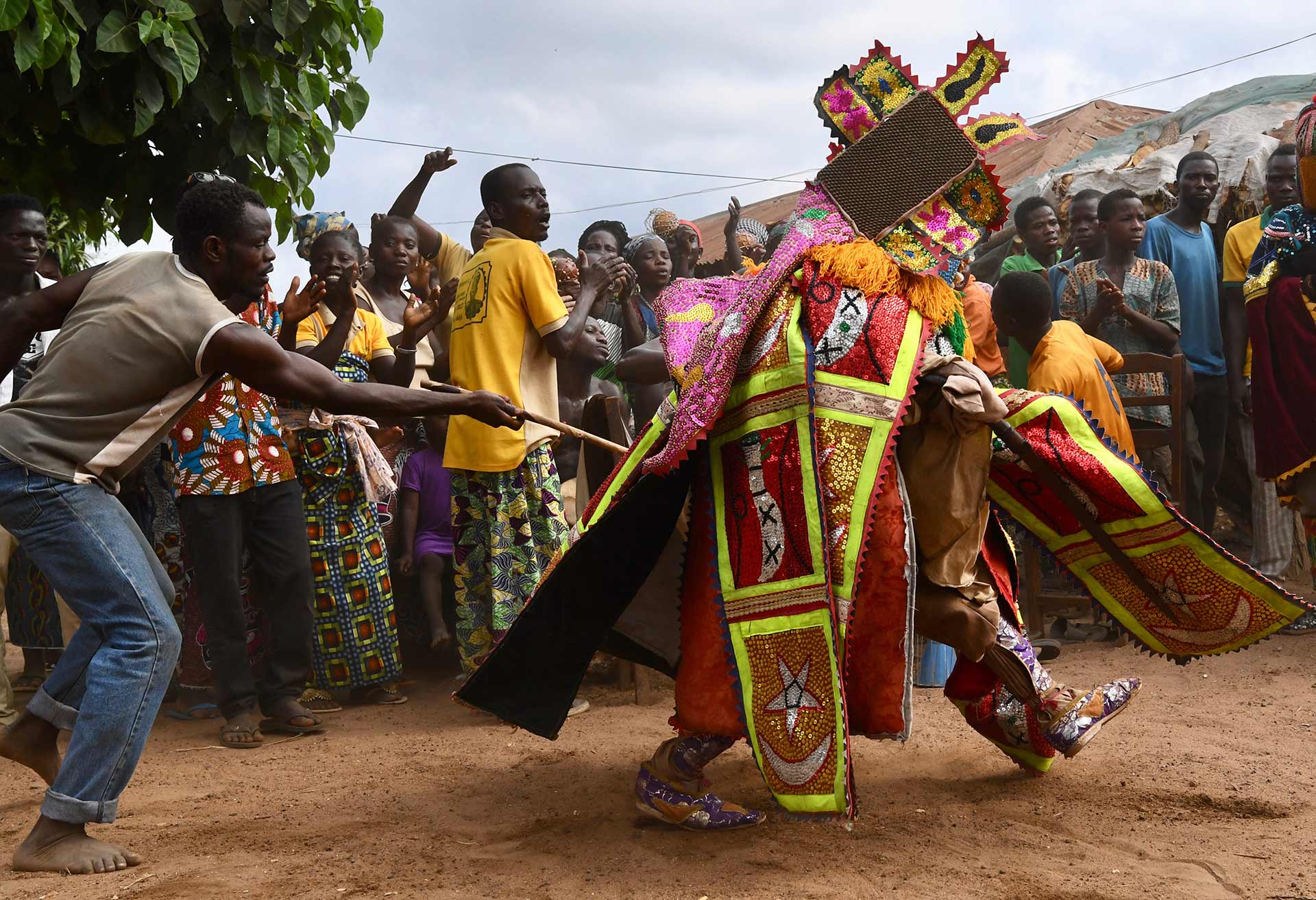Legends of West Africa: Benin to Liberia
A 16-day journey to Benin, Togo, Ghana, Ivory Coast, Liberia
New tour with guaranteed departure
Embark on a 16-day journey from Cotonou to Monrovia, tracing the coasts and cultures of five extraordinary West African nations: Benin, Togo, Ghana, Ivory Coast, and Liberia. Along this rare route, discover stilt villages on shimmering lakes, witness vibrant mask dances, stand before UNESCO-listed slave forts, and encounter living traditions of Voodoo still pulsing through daily life. From bustling markets and historic kingdoms to remote forest communities seldom visited by outsiders, this expertly guided journey with carefully chosen accommodations offers more than a trip—it’s a deep and unforgettable immersion into the living culture of West Africa.
| Tour Information | ||
|---|---|---|
| Duration | : | 16 days |
| Minimum | : | 2 persons |
| Maximum | : | N/A |
| Price (From) | : | |
| International air not included | ||
Day 01: Arrive Cotonou (BENIN)
Welcome to Benin! Known as the birthplace of Voodoo and home to a rich legacy of kingdoms and trade, Benin offers a deep cultural heritage that still shapes West Africa today. Its largest city, Cotonou, serves as the country’s vibrant economic and cultural hub, blending tradition with modern life. Upon arrival, we are met and transferred to our hotel, with check-in from 3 PM.
Overnight: Hotel Azalai (4-star), Cotonou (1 night)
Day 02: Cotonou/Ouidah (Drive)
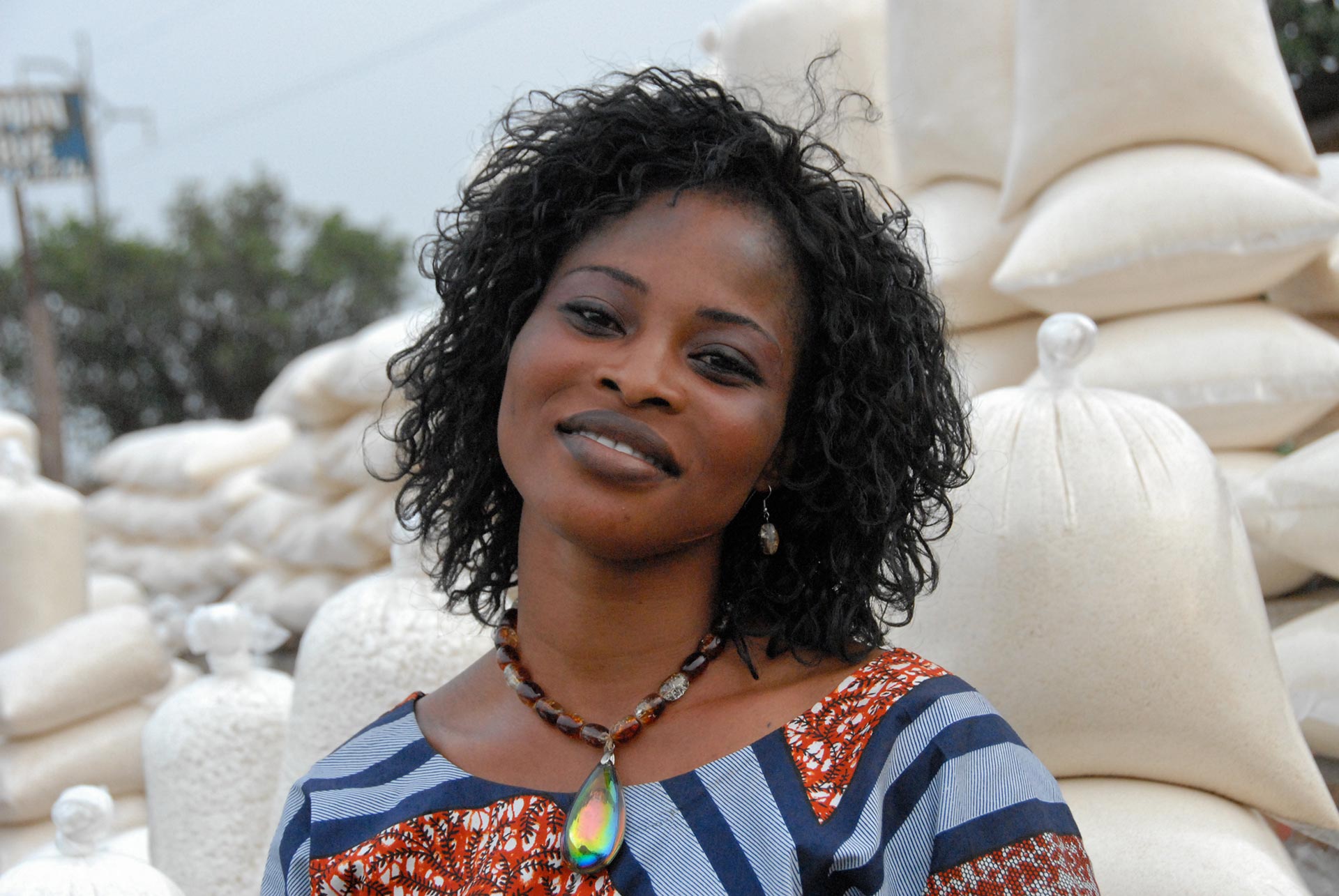
We leave our vehicles and cross Lake Nokwé on a motorized boat to reach Ganvié, the largest and most picturesque African village built on stilts. Its roughly 25,000 residents belong to the Tofinou ethnic group and construct their wooden homes on teak stilts. Fish farming using traditional tribal methods is their primary livelihood. Despite long-standing human settlement, Ganvié has preserved both its traditions and the lake’s ecosystem, which remains far from overfished. Daily life revolves around dugout canoes, expertly rowed by adults and children alike with brightly coloured paddles. From these canoes, men fish, women display their goods at the floating market, and children go to school and play—learning to swim before they walk, as the saying goes in Ganvié.
Travelling along the fishermen’s paths that wind past endless yellow beaches, towering palms, thatched huts, and colourful dugout pirogues, we arrive early at one of the region’s finest coastal resorts. Dinner and overnight are at Hotel Casa del Papa, a 4-star international resort with pristine beaches, a swimming pool, and oceanfront bungalows featuring air-conditioning and private facilities—or similar accommodation.
Overnight: Casa Del Papa (4-star), Ouidah (1 night) (B, L, D)
Day 03: Ouidah/Grand Popo (Drive)
The small town of Ouidah was brought under the Dahomey Kingdom in the 18th century and became a major slave shipping port. We begin our visit by following the “slave road” to the shore, the so-called “Door of No Return,” where enslaved people were sent across the Atlantic. Once known as the “Slave Coast,” Ouidah is notable for its rare Afro-Brazilian architecture, a unique blend of cultures where the Python Temple stands opposite the Catholic Cathedral. The laid-back rhythm of local life, mingled with the distant roar of the ocean and the beat of drums, evokes the haunting echoes of those who were once embarked from these shores—a timeless atmosphere captured by Bruce Chatwin in The Vice-Roy of Ouidah. On foot, we explore the Python Temple and the Portuguese Fort (currently under renovation), now a small but compelling museum detailing Ouidah’s history, the transatlantic slave trade, and the cultural links it created between West Africa and Caribbean Voodoo traditions.
Between lagoons and the ocean, we discover the Zangbeto cult. The Zangbeto Mask, tall and covered with coloured straw, represents wild, non-human spirits—the forces of nature and night that roamed the Earth before humans. Its wearers belong to a secret society, keeping their identities hidden from outsiders. When Zangbeto dances, the entire village takes notice: the performance offers protection against evil spirits and witchcraft, with spinning movements symbolizing spiritual purification. The mask is also said to perform “miracles,” demonstrating its powers.
Overnight: Awale Plage Hotel, Grand Popo (1 night) (B, L, D)
Day 04: Grand Popo/Lome (Drive) (TOGO)
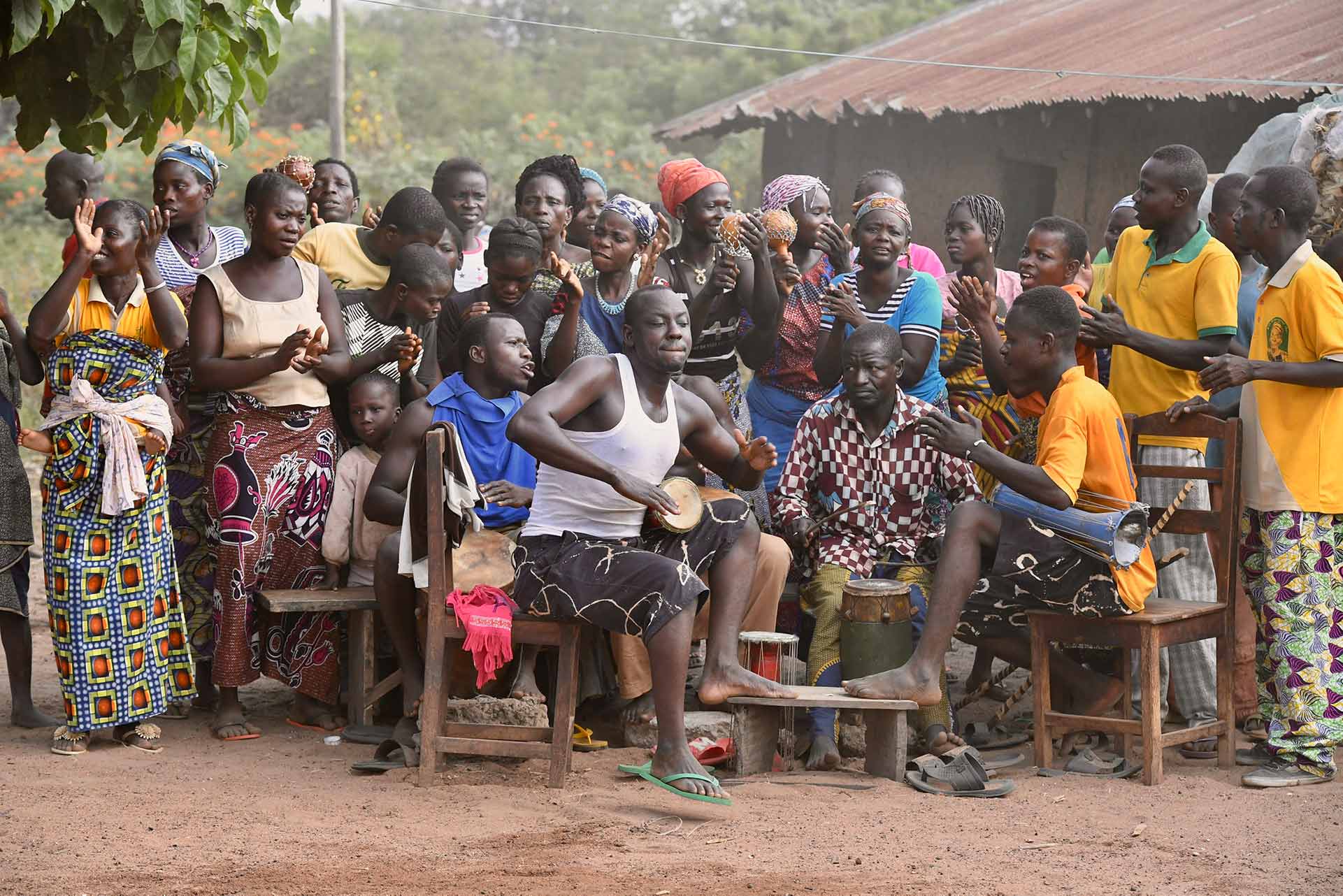
Crossing the border into Togo, we enter a region where Voodoo is the dominant faith along the coast of both Togo and Benin. Authentic ceremonies are still part of daily life: the pounding of drums and the chants of devotees summon the spirits, who may then take possession of participants. Those in trance often display extraordinary signs—rolling eyes, distorted expressions, convulsions, and even a seeming indifference to fire or pain. Among the divinities that may appear are Sakpata, Heviosso, and Mami Water. Immersed in the charged atmosphere of the ritual, we come to grasp the local saying: “In your Churches you pray to God; in our Voodoo shrine, we become Gods.”
Overnight: Onomo Hotel, Lome (1 night) (B, L, D)
Day 05: Lome/Accra (Drive) (GHANA)
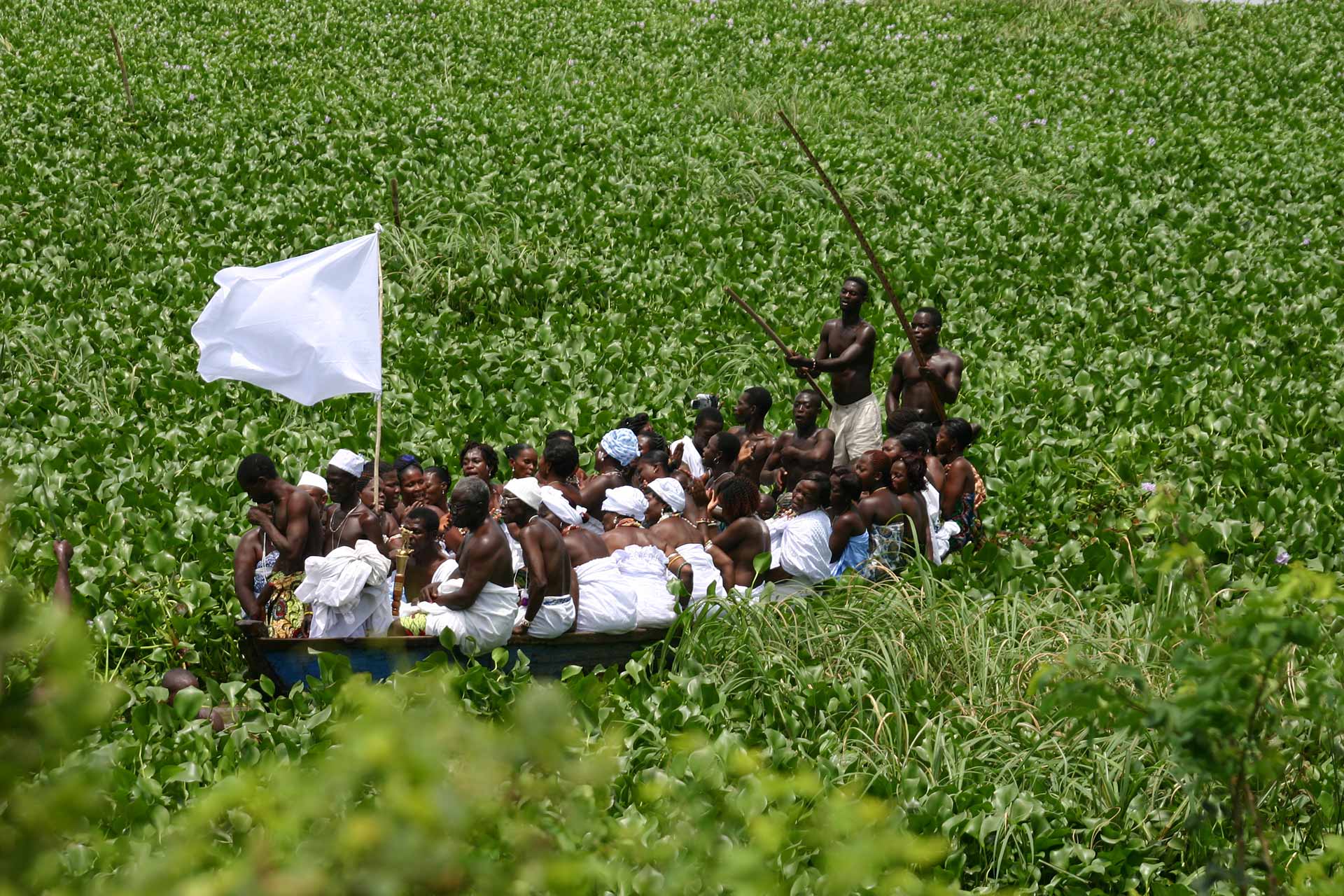
Lomé, the lively capital of Togo, is unique as the only African city once ruled by Germans, British, and French, while also drawing traders from across the continent. Remarkably, it is among the few world capitals situated directly on an international border. These influences have shaped the city’s way of life, blending diverse cuisines, architecture, and traditions. A true crossroads of cultures, Lomé remains cosmopolitan yet welcoming in scale. It is also a key hub for tribal art and artisanal crafts.
We will explore the central market, famous for the “Nana Benz”—women renowned for controlling the trade of luxurious “pagne” fabrics sold throughout West Africa—along with colonial-era buildings and the continent’s largest fetish market, where stalls overflow with ingredients used for potions and rituals. Later, we drive to the Ghana border and continue to Accra.
Dinner and overnight at Villa Boutique, a centrally located 4-star hotel with air-conditioned, self-contained rooms, or similar.
Optional: evening tour of Accra.
Overnight: Villa Boutique (4-star), Accra (1 night) (B, L, D)
Day 06: Accra/Kumasi (Drive)
In the morning, we dedicate time to discovering Accra. Despite rapid modern growth, Ghana’s capital has retained a distinct character. We will explore James Town, one of the city’s oldest districts and home to the Ga people. The tour concludes at a workshop where artisans craft remarkable “fantasy coffins”—elaborate creations shaped like fruits, animals, fish, vehicles, or even airplanes, limited only by imagination.
We then continue our journey to Kumasi. Dinner and overnight at the Miklin Hotel, or similar, where we stay for two nights in air-conditioned, self-contained rooms.
Overnight: Miklin Hotel, Kumasi (2 night) (B, L, D)
Day 07: Kumasi
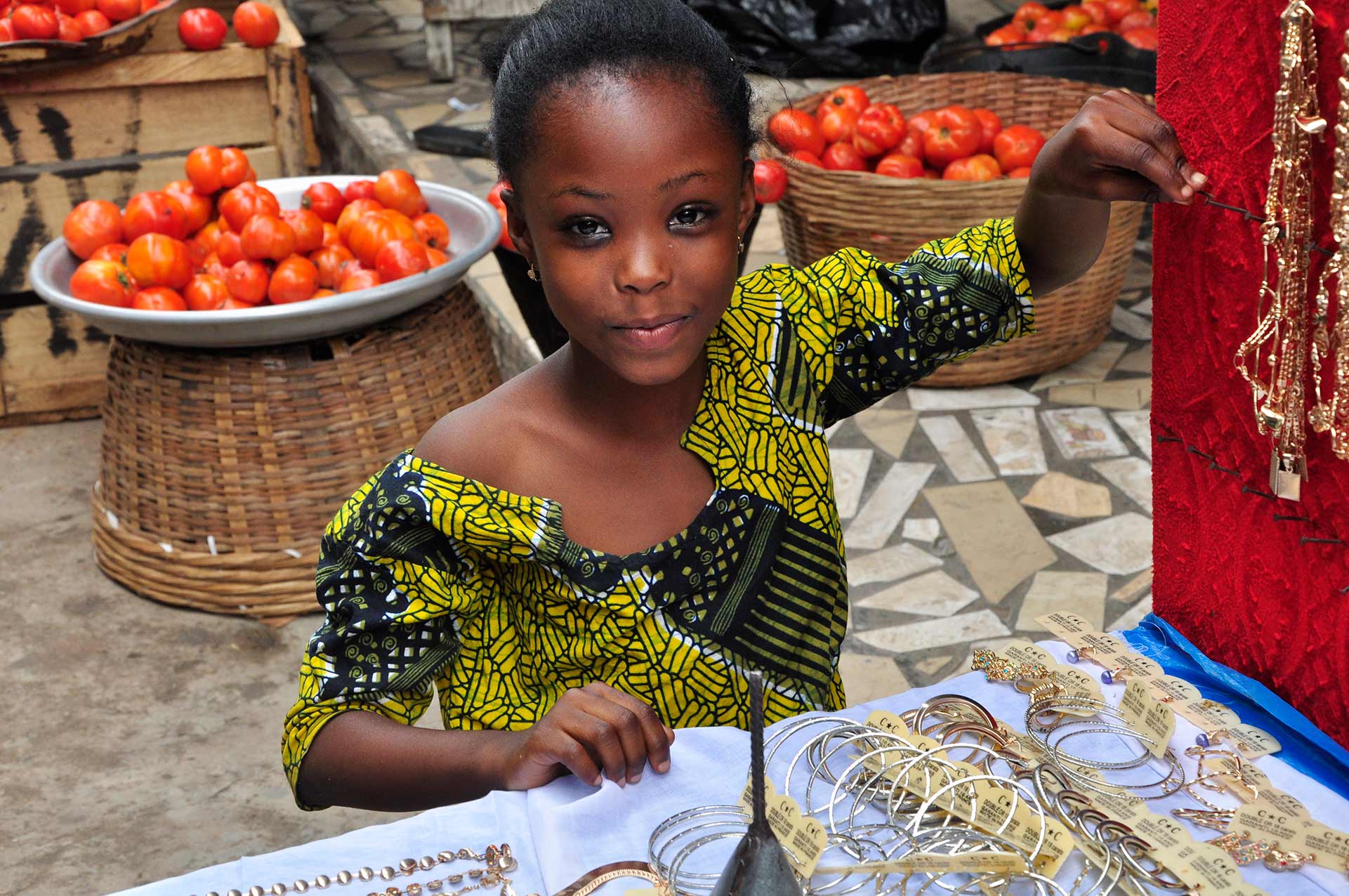
Kumasi is the historic and spiritual heart of the former Ashanti Kingdom. Once one of Africa’s most powerful states, the Ashanti retained influence until the late 19th century, when the British incorporated their territory into the Gold Coast colony. Today, with over three million residents, Kumasi is a lively city centered around its enormous central market—among the largest in Africa—where everything from Ashanti handicrafts (leatherwork, pottery, Kente cloth) to an astonishing variety of tropical produce is sold.
Our program includes a visit to the Ashanti Cultural Centre, which houses an exceptional collection of artifacts inside a reconstructed traditional Ashanti house. We will also be welcomed by a traditional Ashanti chief, giving us the opportunity to witness or take part in a cultural meeting or ceremony.
Dinner and overnight once again at the Miklin Hotel, in air-conditioned, self-contained rooms. (B, L, D)
Day 08: Kumasi/Elmina (Drive)
In the morning, we set out for Elmina to explore the historic slave trade castles. The most prominent, São Jorge da Mina, was built by the Portuguese in 1482 and is considered the oldest European building in Africa. Over the centuries, the fortress served as a trading post—first for gold, later ivory, and eventually enslaved people. This coastline was once known as the “Gold Coast.”
The castle we visit today reflects centuries of modifications and expansions and is now recognized as a UNESCO World Heritage Site. Just across from the fortress lies a bustling fishing harbour, where hundreds of brightly painted wooden canoes line the shore.
Dinner and overnight at the oceanfront Anomabu Beach Resort, with spacious, air-conditioned bungalows—or similar.
Overnight: Anomabu Beach Resort, Elmina (1 night) (B, L, D)
Day 09: Elmina/Aboisso (Drive) (IVORY COAST)
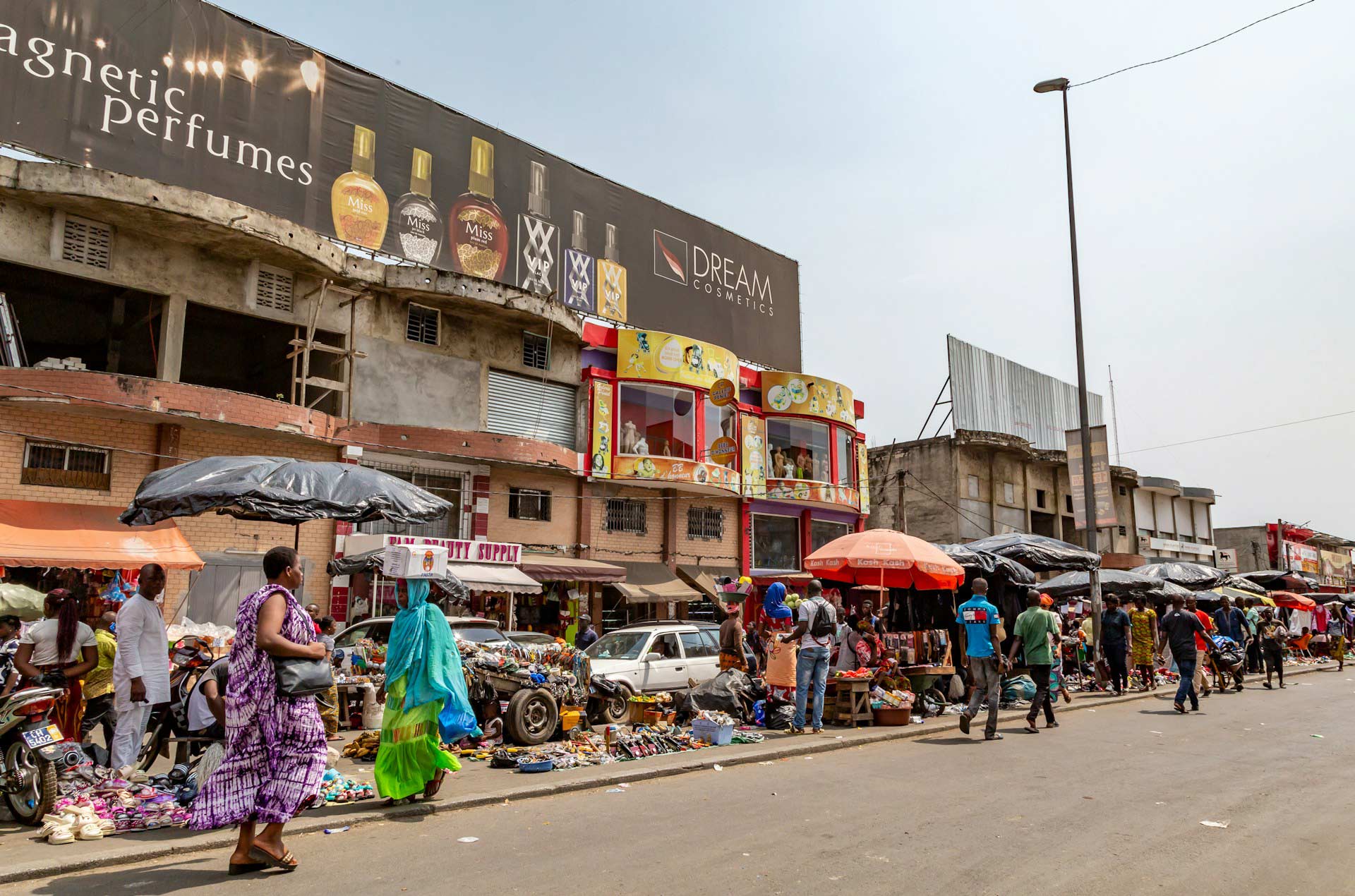
We set out early and stop at an ancient village to discover the Posuban—shrines of the Asafo companies, where Asafo “warriors” still pour libations today. Walking through the alleys of the old town, we are immersed in an atmosphere that recalls a time before colonial rule, when this area became the first hub of permanent trade between Europeans and sub-Saharan Africa.
At Axim we visit Fort San Antonio, built by the Portuguese in 1515 near the mouth of the Ankobra River. Situated on a rocky outcrop facing the ocean, this heavily fortified stronghold became the main centre for gold trading along the former Gold Coast.
From Axim we continue our journey to the border with Côte d’Ivoire, whose name reflects its history in the ivory trade, and reach the riverside town of Aboisso on the Bia River.
Dinner will be enjoyed at lively open-air restaurants in the central square—a safe and authentic introduction to African street food. Overnight at Hotel Le Rochè, with air-conditioned en suite rooms (note: no twin rooms available), or similar.
Overnight: Hotel Le Roche, Aboisso (1 night) (B, L, D) – No twin rooms available
Day 10: Aboisso/Abidjan (Drive)
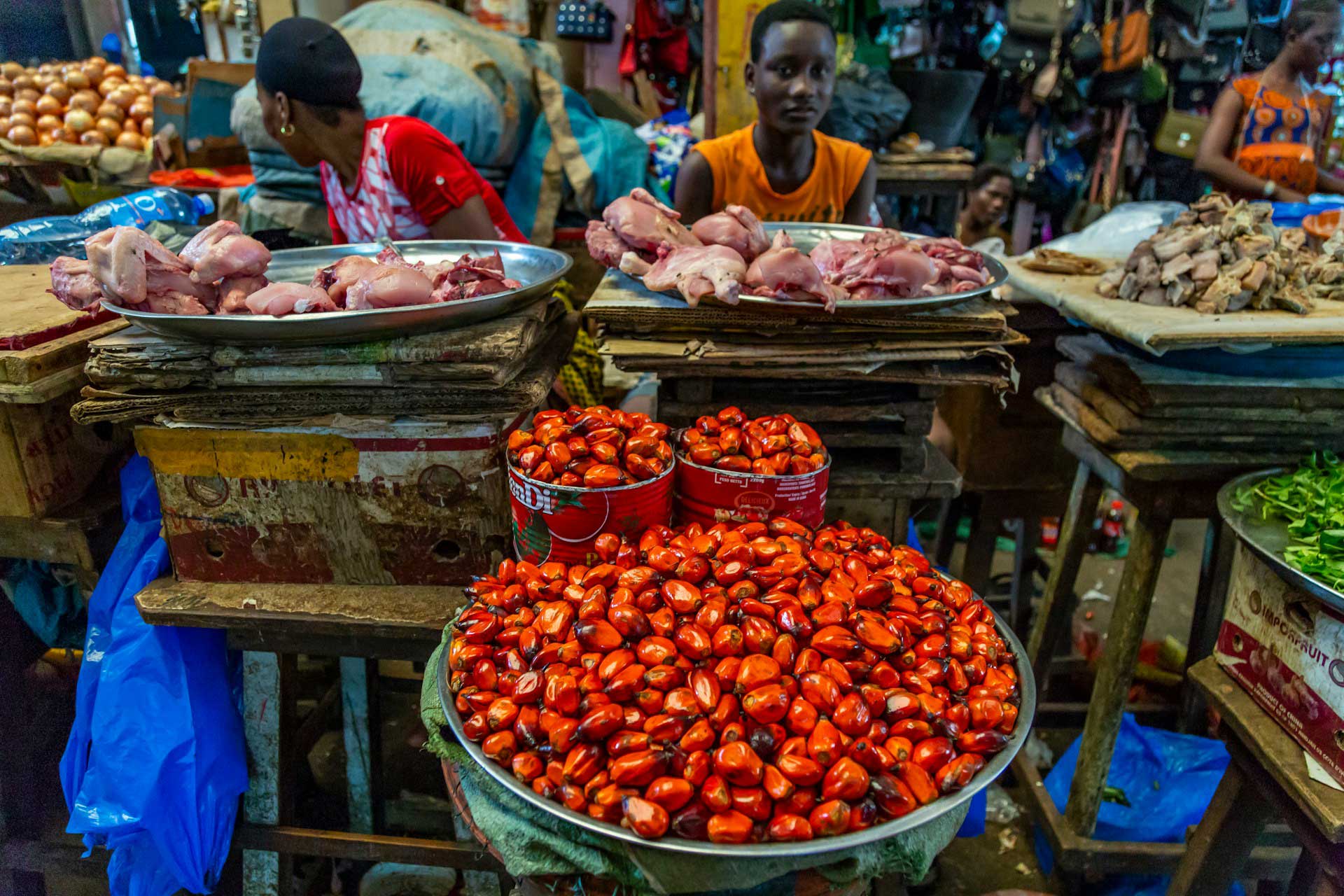
We arrive in Grand-Bassam, a historic town set on a sandbar between the lagoon and the ocean. Once the capital of the French colony of Côte d’Ivoire, it is today a seaside retreat for people from Abidjan. Its shaded avenues lined with tall trees, vivid bougainvillea, and well-preserved colonial architecture create a uniquely atmospheric charm.
Highlights include the old post office, a fine example of colonial design, and the Costume Museum, housed in the former governor’s palace. With its sweeping outdoor staircase and remarkable collection of masks, costumes, ornaments, and ethnographic photography, the museum provides an exceptional window into the country’s cultural heritage.
We continue westward toward Abidjan. Overnight at the modern and comfortable Azalai Hotel, a four-star property of international standard, or similar.
Overnight: Azalia Hotel (4-star), Grand Bassam (1 night) (B, L, D)
Day 11: Abidjan/Yamoussoukro (Drive)
Beyond the lagoon lies the “Plateau,” Abidjan’s fast-growing City District. Unlike most African cities, expansion here is vertical, with modern high-rises and skyscrapers dominating the skyline. With little land available, new space is continually reclaimed from the Ebrié Lagoon. To the west, the harbour bustles with crowds waiting for public boats, while to the east the silhouette of Saints Peter & Paul Cathedral rises against the horizon. The rapid pace of development—reflected in the country’s 6% GDP growth since the civil war—also brings with it heavy, chaotic traffic.
In the afternoon, we take the motorway toward Yamoussoukro. Dinner and overnight at the comfortable Royal Hotel, featuring air-conditioned self-contained rooms and a swimming pool, or similar.
Overnight: Royal Hotel, Yamoussoukro (1 night) (B, L, D) – No Twins available
Day 12: Yamoussoukro/Daloa (Drive)
Yamoussoukro has served as Ivory Coast’s official capital since 1983 and is also the birthplace of Houphouët-Boigny, the first President of independent Ivory Coast. It reflects the Ivorian dream of the 1970s and 1980s—a nation with limited natural resources that nevertheless built the largest economy in French-speaking West Africa. We visit the Basilica of Our Lady of Peace, modeled on St. Peter’s in Rome and recognized as the largest Christian church in the world, adorned with stunningly tall and colorful stained-glass windows. Driving along wide boulevards where only a few cars share space with zebus and chickens, we also see oversized government buildings, high-rise hotels, and even a man-made lake inhabited by crocodiles, creating a surreal atmosphere.
In a nearby village, we experience the Zaouli dancing masks. This traditional performance of the Guro people, first created in the 1950s and linked to the figure of “Djela Lou Zaouli,” is famous for its incredibly refined and intricate leg and footwork, with each mask carrying its own symbolic meaning.
We continue to Daloa for dinner and overnight at Hotel La Grace, featuring self-contained air-conditioned rooms, or similar.
Overnight: Hotel La Grace, Daloa (1 night) (B, L, D) – No Twins available
Day 13: Dalao/Man (Drive)
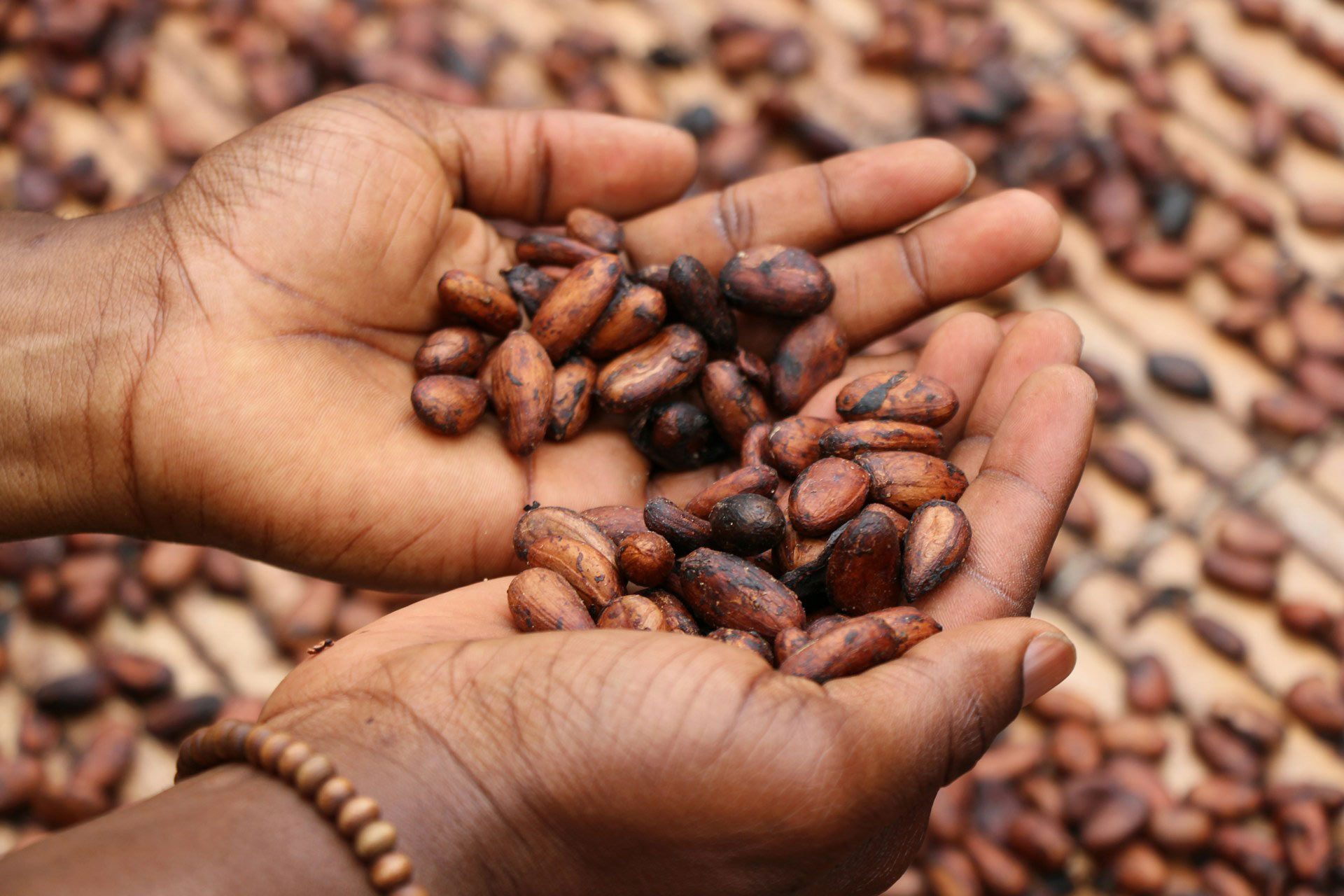
We begin our journey through lush coffee and cocoa plantations, punctuated by small villages. Ivory Coast is the world’s largest cocoa producer, followed by Ghana, and together they account for more than half of global supply. Leaving the main road behind, we travel by 4x4 into remote forest settlements where visits from outsiders are uncommon, to meet the Guere people. Here, we witness the striking Guere Masks, which emerge from sacred forests to dance in the village when distinguished guests are welcomed.
With luck, we may also see the rare performance of the “Jugglers,” a vanishing initiation ritual once widespread among girls but now preserved only in a few villages. The Dan and Guere peoples are renowned for their masks, widely considered masterpieces of African art.
By evening, we reach the small town of Man, encircled by 18 verdant mountains and known as the capital of this forested region. We spend two nights here at Hotel Amoitrin, offering air-conditioned, self-contained rooms and a swimming pool, or similar accommodation.
Overnight: Hotel Amoitrin, Man (2 nights) (B, L, D)
Day 14: Man – Masks & Markets
We dedicate the day to exploring the Man region. While the Guéré masks are celebrated for their bold and powerful presence, the Dan masks are admired for their exquisite craftsmanship, balancing shapes that symbolize beauty. In a nearby village, the masks emerge from the forest to meet us. According to Dan cosmology, a creator god communicates with humans only through these masks. During the dance, the boundary between human and spirit worlds fades, restoring cosmic and social order and expressing gratitude to the gods and ancestors.
We also visit the Man market, a key trading hub drawing villagers from across the region and forests of neighboring countries. Here, we can explore a rich selection of handicrafts, and with luck, discover authentic tribal masks and ritual objects.
Dinner and overnight return to Hotel Amoitrin, with air-conditioned, self-contained rooms and a swimming pool, or similar.
Overnight: Hotel Amoitrin, Man (2 nights) (B, L, D)
Day 15: Man/Gbarnga (Drive) (LIBERIA)
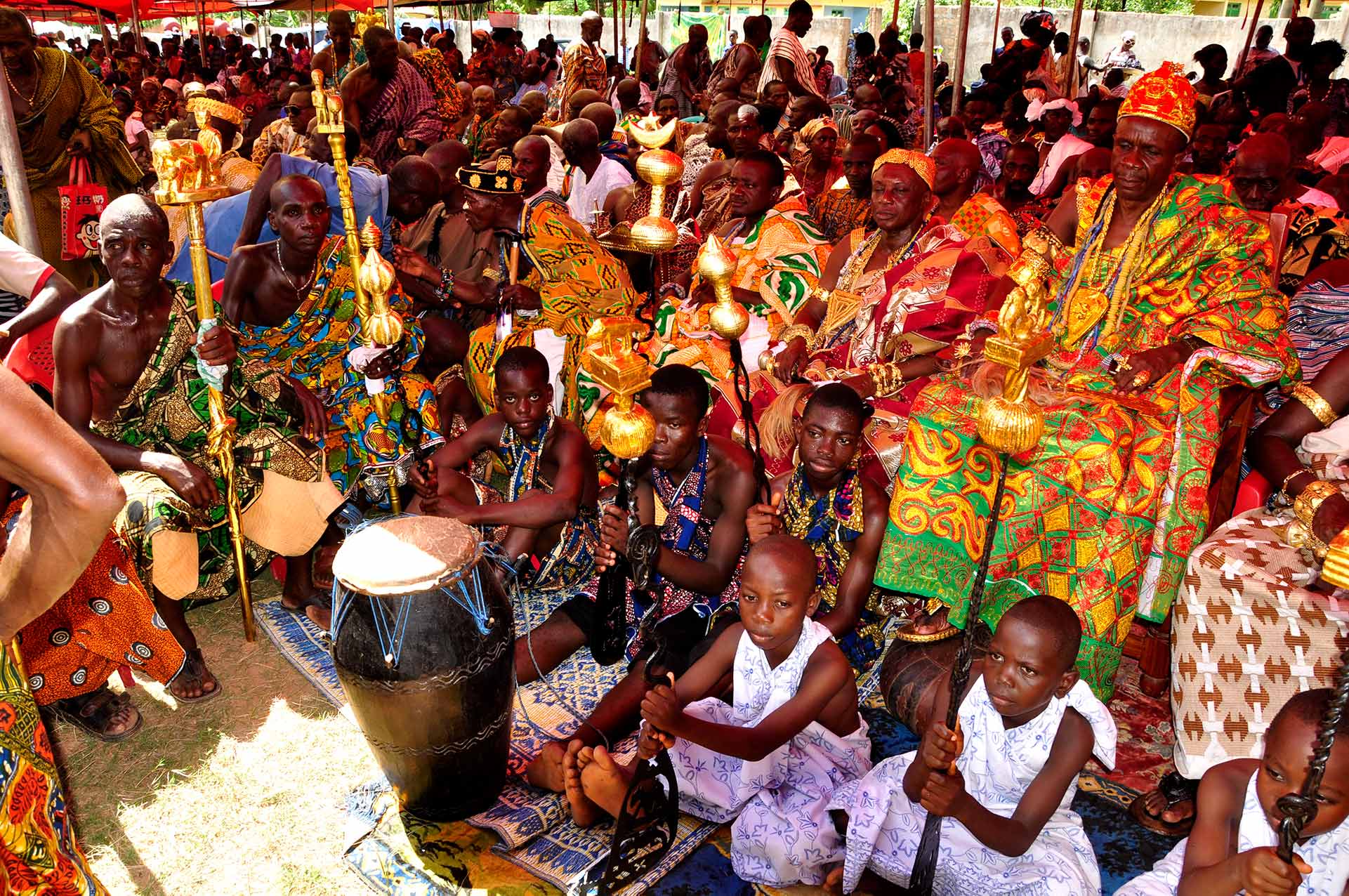
We travel along a road lined with lush vegetation to reach a remote village, followed by a short walk to a spectacular liana bridge spanning a large jungle river. These bridges are masterpieces of authentic “tribal technology,” constructed entirely from forest materials like wood and lianas, without nails, rope, or anything foreign. Only the initiated are permitted to harvest the materials, believed to be guided by a powerful spirit to complete the bridge overnight. During the construction of a new bridge, neither women nor uninitiated people may enter the forest, preserving the secrecy of this “magical technology.”
After completing the formalities, we cross the border into Liberia, traveling through hilly, verdant landscapes. In earlier times, European navigators called this coastline the Pepper Coast, famed for trading the rare Melegueta Pepper, once known as the Grain of Paradise.
We arrive in the evening at Gbarnga. Dinner and overnight stay at Hotel Passion 2, with air-conditioned, self-contained rooms (no twin rooms available), or similar.
Overnight: Hotel Passion 2, Gbarnga (1 night) (B, L, D) – No Twins available
Day 16: Gbarnga/Depart Monrovia (Drive)
Taking Part 2 alone requires arrival in Monrovia on March 19.
We arrive in Monrovia, the capital of Liberia, for lunch. Liberia is the only African country never colonized or made a protectorate. The nation was founded by freed slaves returned from America, known as the Krio people, who today represent around 5% of the population. Considered the creators of the nation, they remain key actors in modern politics and the economy. About 80% of Liberians speak Kreyol, a form of American English “pidgin.”
In the afternoon, we begin exploring the town from our ocean-view hotel, an ideal base. We visit the Grand Masonic Temple, reflecting the strong influence of Freemasonry on Liberia’s history and Krio culture. We also see what remains of the Ducor Palace, once one of Africa’s first five-star hotels, perched on Monrovia’s highest rocky hill overlooking the city and the bay. The hotel hosted African elite gatherings during independence and is now abandoned, though with permission, a visit may be possible.
Next, we visit the National Museum, a striking example of Krio architecture, housing an extensive collection of ancient masks, ritual objects, and a photographic exhibit on Liberia’s civil wars from 1989 to 2003.
Transfer to the airport for departure flight. (B, L)
B=Breakfast, L=Lunch, D=Dinner
Departure Dates & Prices
We accept payments in US$, CA$ as well as in other convertible currencies like EUR, AUD and GBP. Tour prices have been costed in US$. CA$ price shown below is an indicative amount reached at by using the conversion rate at the time of web posting and will be applicable if there is no change in the conversion rate. Should the currency conversion rate change, the US$ pricing will prevail. Bestway Tours & Safaris offers a conversion rate protection. Once full payment has been received and no modification has been made to the tour itinerary, we will honour that rate. For complete payment procedures, please click here
| 2026 | Per Person on Twin Sharing |
Single Room Supplement |
|---|---|---|
| Departures | ||
| MARCH 2026: Start in Cotonou on March 5 & end in Monrovia evening of March 20, 2026 | ||
| March 5, 2026 | US$ 8340 | US$ 1198 |
Reduction of US$ 855 per person if 6 or more guests confirm on departure.
Reduction of CA$ 1231 per person if 6 or more guests confirm on departure. |
||
| DECEMBER 2026: Start in Monrovia on December 19, 2026 & end in Cotonou January 3, 2027 | ||
| Based on 2 or 3 participants | US$ 9315 | US$ 1199 |
| Based on 4 or 5 participants |
US$ 8340 | US$ 1199 |
| Based on 6+ participants |
US$ 7485 | US$ 1199 |
| 2026 | Per Person on Twin Sharing |
Single Room Supplement |
|---|---|---|
| Departures | ||
| MARCH 2026: Start in Cotonou on March 5 & end in Monrovia evening of March 20, 2026 | ||
| March 5, 2026 | CA$ 12002 | CA$ 1724 |
Reduction of US$ 855 per person if 6 or more guests confirm on departure.
Reduction of CA$ 1231 per person if 6 or more guests confirm on departure. |
||
| DECEMBER 2026: Start in Monrovia on December 19, 2026 & end in Cotonou January 3, 2027 | ||
| Based on 2 or 3 participants | CA$ 13405 | CA$ 1726 |
| Based on 4 or 5 participants |
CA$ 12002 | CA$ 1726 |
| Based on 6+ participants |
CA$ 10771 | CA$ 1726 |
Guaranteed Departures
| This tour can also be taken in smaller legs. Please contact us for details if you are interested in a specific segment. |
Notes
- Important note on visas: After booking, please contact us immediately via visas. We will provide advice and suggestions on how to obtain the E-Visas and when Invitation Letters are required, even if not explicitly requested by local authorities. Visa rules are frequently updated, so we will send the most current information available.
- Deposit is 30% of tour price.
- Climate: Climate: This departure is scheduled to take advantage of ideal weather. Spring falls within the dry season, making it the best time to explore West Africa.
- Comfort: To truly enjoy a long journey off the beaten path, comfort is essential. For rough tracks and desert dunes, we use modern 4x4 vehicles with air-conditioning, while well-maintained minibuses handle the smoother main roads. Overnight stays include four-star (****) or character-rich hotels in the capitals, and newer properties with private bathrooms and air-conditioning elsewhere. Each accommodation is selected for its comfort, quality dining, friendly atmosphere, architectural charm, and scenic setting.
- Safety: Your well-being comes first. This expedition is backed by years of regional expertise and led by experienced guides. A trusted local network provides constant monitoring and real-time updates, ensuring the route remains secure at all times.
Expedition leaders have extensive experience guiding travelers off the beaten track in this region, with an excellent understanding of African culture and traditions.
This is an exploratory itinerary. Participants must be flexible and ready to enjoy unique encounters, as well as some unexpected situations that are part of the African experience. - Vaccinations: Yellow fever is compulsory. Malaria prophylaxis is highly recommended. Cholera is not currently required, but please check prior to departure.
- Luggage: Due to the exploratory nature of the itinerary, luggage should be limited to approximately 20 kg (45 lbs).
- Travel insurance: Not included. It is mandatory for medical assistance, repatriation, and coverage of material or physical damages.
- Hotels: We have carefully selected hotels for quality of service and, where possible, architectural character. Due to potential room availability issues, the tour leader may replace hotels with similar alternatives. Four-star hotels are used in capitals, and the best available hotels inland, always with air-conditioned rooms. Hotel staircases may have uneven steps, so please take care.
- Meals: Lunches will include cold meals, picnics, or meals at restaurants with pre-selected menus. Dinners will be at hotel restaurants with pre-selected menus. One bottle of water per day is included during visits.
- Notice: The itinerary is designed to explore fascinating places, where visits by foreigners often remain exceptional events. Participants should be cooperative, tolerant, and flexible to fully enjoy the expedition and appreciate the unique landscapes, as well as the spontaneous hospitality, magic, and mystery of Africa, including local metaphysics, ceremonies, life philosophies, and beliefs that the people share with us.
Itineraries, visits, and overnight accommodations may be modified due to local conditions or force majeure. Only the organizers and the tour leader can decide on any changes.
Inclusions
- 15 Nights' accommodation as mentioned or similar, including hotel taxes
- 44 Meals as mentioned (B=Breakfast, L=Lunch, D=Dinner)
- All sightseeing and transfers by 4WD vehicles, minibus and boats
- Services of local English speaking guides
- Entrance fees to museums, sites & game parks included in the itinerary
- International airfares
- Insurance/visas
- Tips/gratuities
- Mineral water and drinks at restaurants & hotel
- Portage
- Photography fees
Participants
This tour operates on a minimum of 2 participants
Customised Itinerary
If you would like to have a tour on dates other than the above ones or with a customised itinerary, please contact us and we will be happy to work out an exclusive program for you.
Contact Info
Email us at bestway@bestway.com or call 1-604-264-7378.
Residents of U.S.A./Canada may call us toll free at 1-800-663-0844.
Inquire About this Trip
Tour Application Form

